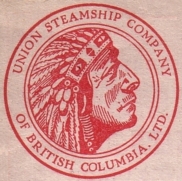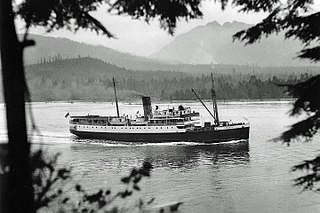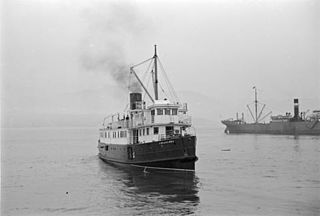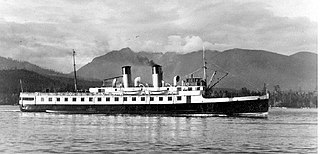
The Grand Trunk steamship Prince Rupert and her sister ship SS Prince George served the coast of British Columbia and Alaska. Prince Rupert had a 45-year career serving northern ports from Vancouver, British Columbia, from 1910 to 1955. The ship was considered "unlucky" and suffered several incidents during her career, including two significant ones that left large portions of the vessel underwater. The ship was broken up in 1956.

SS Catala was a Canadian coastal passenger and cargo steamship built for service with the Union Steamship Company of British Columbia.

The steamship Sechelt operated from 1893 to 1911 on Lake Washington, Puget Sound and the Strait of Georgia. For most of her career, she was called Hattie Hansen. She became well known following her unexplained sinking with no survivors near Race Rocks Lighthouse in 1911.

MV Lady Rose is a small, single-screw, diesel coastal vessel, which operated on the west coast of British Columbia, Canada.

The Union Steamship Company of British Columbia was a pioneer firm on coastal British Columbia. It was founded in November 1889 by John Darling, a director of the Union Steamship Company of New Zealand, and nine local businessmen. The company began by offering local service on Burrard Inlet near Vancouver and later expanded to servicing the entire British Columbia coast.
The Western Dry Dock and Shipbuilding Company was a shipyard that operated at Port Arthur, Ontario, now part of Thunder Bay, on Lake Superior from 1911 to 1993. The shipyard was established in 1909 and renamed in 1916 as the Port Arthur Shipbuilding Company. The yard closed in 1993. It reopened as a repair yard Lakehead Marine and Industrial, however that venture failed in 2014. As of 2016, the shipyard was purchased by Heddle Marine. It is operated by Heddle Marine in partnership with Fabmar Metals Inc, of Thunder Bay. The venture focuses on ship repair services and winter layup options.

For more than 35 years, from 1923 to 1958, the Union steamship Cardena sailed the British Columbia Coast, carrying passengers, groceries, dry goods, industrial cargo, mail and sundry other supplies to the 200 or so mining, logging and fishing communities that once dotted the province's coastline during the early years of the 20th century. On her return voyage, at the peak of the summer fishing season, Cardena routinely carried thousands of cases of canned salmon to the railheads at Prince Rupert and Vancouver for shipment across Canada and around the world. And so it went for the better part of half a century; a regular and reliable marine service that made Cardena a coastal institution, remembered with affection and regard by the countless men, women and children who inhabited those tiny outports in a bygone era.

Capilano was a steamship built in 1920 in British Columbia, which served until 1949.

Comox was a steamship built in 1891 in British Columbia which served until 1920. Comox was the first steel ship built on the west coast of North America north of San Francisco.

Cutch was a steamship built in 1884 in Hull, England. The ship served as a pilgrimage vessel and a yacht in India from 1884 to 1890, then as a steamship in British Columbia from 1890 to 1900 under the ownership of the Union Steamship Company. The ship was wrecked in August 1900, then salvaged and registered in the United States as Jessie Banning. In 1902 the ship was transferred to the navy of Colombia where it was armed with cannon and served in the Colombian navy as the gunboat Bogota. Bogota shelled the city of Panama on November 3, 1903 during the secession of Panama from Colombia.

Lady Alexandra was a steamship built in 1924 in Montrose, Scotland which served in British Columbia from 1924 to 1952, mostly on Howe Sound.

Cowichan was a steamship which was operated in British Columbia under the ownership of the Union Steamship Company. Cowichan sank in 1925 following a collision with another ship.

Princess Louise was a sidewheel steamboat built in 1869. From 1869 to 1879 this ship was named Olympia. In 1879 the name was changed to Princess Louise, after Princess Louise, Duchess of Argyll, a daughter of Queen Victoria who was married to Marquess of Lorne (1845-1914), Governor General of Canada from 1878 to 1883. Princess Louise was the last sidewheeler to be operated commercially on the coast of British Columbia.

The Grand Trunk Steamship Prince George, and sister ship SS Prince Rupert, provided passenger service along the coasts of British Columbia and Alaska. In service from 1910 until 1945, the vessel saw brief service as a hospital ship for the Royal Canadian Navy during World War I. In 1945 the ship caught fire in the harbour of Ketchikan, Alaska. The burned hulk was beached on Gravina Island where it remained for the next few years until it was towed to Seattle, Washington and broken up for scrap.

Cheakamus was a steamship built in 1913 in North Vancouver, British Columbia. This ship was originally built as the Cheslakee in Scotland. After Cheslakee capsized in 1913, the hulk was raised, lengthened, and placed back into service as Cheakamus.

Camosun was a steamship built in 1904 in Paisley, Scotland which served in British Columbia.

Lady Cynthia was a steel-hulled passenger ship converted from a minesweeper,, which served in the coastal waters of British Columbia from 1925 to 1957. Lady Cynthia was a sistership to Lady Cecilia, also a converted minesweeper. The ship was generally referred to as the Cynthia while in service.

Chelosin was a steel-hulled, steam-powered passenger-freighter vessel that served in coastal British Columbia from 1911 to 1949, under the ownership of the Union Steamship Company of British Columbia.

Chasina was an iron-hulled, steam-powered ship, originally built as a steam yacht, but later converted to a passenger-freighter vessel that served in coastal British Columbia and other areas during the early decades of the 1900s under the ownership several different companies. The ship disappeared in 1931 after leaving Hong Kong.

SS Prince George was a passenger ship built in 1947 for the Canadian National Steamship Company, to ply the route from Vancouver, British Columbia, to Southeast Alaska.




















